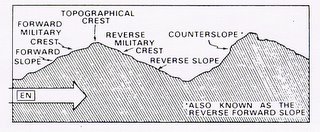Defense.
This is coolbert:
It is called the Reverse Slope Defense.
That form of defense that allows the infantryman, defending, to inflict the maximum number of casualties upon an attacker.
"A reverse slope defense is a positioning technique characterized by the location of defensive forces on a slope of a hill, ridge, or mountain that descends away from the enemy. It is one of several time tested techniques that may be used as part or all of a unit defense."
That form of defense that was determined to be the most effective by the German operations research analysts of World War One [WW1].
I have blogged on this topic before. See my blog of 4/06/2004 for all the details.
This form of defense is recognized by the U.S. Army in it's field manuals as being valid. To what extent it IS taught to infantry commanders I am just not sure. I will investigate this.
This drawing best describes, better than words, what the reverse slope defense consists of:

This IS counter-intuitive to what the novitiate may feel is appropriate. I think most folks would expect the most effective and lethal defensive position to be one established at the forward military crest of a hill being defended. This IS NOT SO!
Factors as to WHY this is not so were not readily apparent to me. Somewhat intuitive but not enunciated when I first was exposed to this concept [reverse slope defense].
It seems that the experts see the factors for successful and effective defense using the reverse slope defense as being:
"The reverse slope defense protects the infantryman from enemy long-range direct and indirect fires."
"A reverse slope defense is especially useful when the light infantryman finds himself on terrain which is exposed to enemy long range fire systems."
"The reverse slope defense brings the battle into the range of infantry weapons."
"Positions on the reverse slope are hidden from enemy observation and can hide your strength and locations."
"BOTTOM LINE
The reverse slope defense can (depending on METT-T) provide a critical "edge" to the light fighter on the firepower intensive battlefield."
The gist seems to be that you, the defender, can bring all your weaponry to bear upon an attacking enemy, but the attacker CANNOT BRING HIS full panoply of weaponry to bear upon you. YOU are protected from observation, and indirect fire, while the enemy is not. YOU have the advantage as your positions are not observable until the point when the enemy finds themselves full exposed to the full range of your firepower.
Some anecdotal accounts of the advantages offered by reverse slope defense tell a lot:
"On top of that ridge were some German assault guns, and they waited until the company commander had all of his troopers scattered around in their foxholes on the forward slope, and then, they just started firing with their two assault guns. It was murder. Finally, after they killed and wounded maybe 20 men in that company, the rest of them just got up and bolted out of there and went over to the reverse slope, which is where they belonged in the first place. So, being on a forward slope when the enemy has direct fire weapons, high velocity direct fire weapons, is suicide."
"However, trying to continue the advance, the soldiers discovered that the Japanese had also fortified the reverse slope with 55 emplacements including 13 pillboxes. Once again artillery was called in, including shells using the new VT fuses. Under the cover of a smoke screen and with quad .50 caliber machine guns blazing, the men of the 6th Division stormed those positions on 8 July, but at heavy cost. The reverse slope defenses, unexpected and virtually impervious to observed artillery fire, proved to be more costly to take than forward slope positions."
"As a result, the Chinese decided to put their forces, "front light, rear heavy." That is, they put a few reconnaissance troops on the forward slope of the hill while putting most of their troops on the reverse slope. They were placed "in well-protected holes dispersed over the crest of the hill from where one can easily push forward." These units achieved the maximum protection from the deadly effects of direct and indirect fire weapons at a minimum loss in defensive power. When facing an enemy rich in artillery and air power, the reverse slope defense proved a good bet for the Chinese."
"Argentine defensive positions in the Falklands were normally located on the forward slopes. This permitted the British forces to observe and accurately locate the Argentine positions. They then would direct accurate artillery fire and antitank guided missiles into those exposed positions. The Argentines were driven out of their holes by this concentrated fire."
See this further drawing which shows how an reverse slope defense can be organized. Observation and listening posts on the forward crest of the hill being defended. Main defense located on the reverse slope.

I hope this sort of defense is just not textbook and IS taught at the U.S. Army Infantry School. Let me try to find out.
coolbert.

0 Comments:
Post a Comment
Subscribe to Post Comments [Atom]
<< Home